泥炭、堆肥和生物炭对锌污染场地修复的吸附和经济可行性
IF 2.2
4区 工程技术
Q3 ENGINEERING, GEOLOGICAL
引用次数: 0
摘要
近几十年来,对低成本吸附剂的需求不断增长,这保证了去除污染物的生态效率,导致了许多研究。从这个意义上说,从有机残留物中提取的吸附剂显示出有希望的选择;然而,迄今为止,城市固体废物的有机部分(OFMSW)很少受到关注。本研究比较了传统吸附剂(泥炭)和来自OFMSW的材料(堆肥和生物炭)的锌(Zn)吸附性能。根据Langmuir模型,生物炭的吸附量最大(53.494 mg g−1),其次是堆肥(37.569 mg g−1)和泥炭(5.842 mg g−1)。线性和非线性回归调整后的最大吸附量接近,但只有在达到饱和平台时才具有相关性。与市售吸附剂相比,所研究吸附剂的成本估算验证了它们的经济可行性。这些发现为更好地理解吸附实验提供了理论基础,从初始浓度的选择到结果的等温建模,以便对潜在的吸附剂进行比较评估,以修复被潜在有毒金属(如锌)污染的土壤和水域。本文章由计算机程序翻译,如有差异,请以英文原文为准。
Sorption and economic viability of peat, compost, and biochar for Zn-contaminated site remediation
The growing demand for low-cost sorbents, which guarantee eco-efficiency in removing contaminants, has led to numerous studies in recent decades. In this sense, sorbents derived from organic residues have shown promising options; however, the organic fraction of municipal solid waste (OFMSW) has received little attention to date. This study compares the zinc (Zn) sorption performance of a traditional sorbent (peat) to that of materials derived from OFMSW (compost and biochar). According to Langmuir model, biochar showed the highest sorption capacity (53.494 mg g −1 ), followed by compost (37.569 mg g −1 ) and peat (5.842 mg g −1 ). Although the maximum sorption capacities adjusted by linear and non-linear regressions were close, the values were relevant only when they reached the saturation plateau. The cost estimate of the studied sorbents validated their economic viability compared to commercially available ones. The findings provide a theoretical basis for a better understanding of sorption experiments, from the choice of initial concentrations to the isothermal modelling of the results, for comparative evaluations of potential sorbents for the remediation of soils and waters contaminated with potentially toxic metals, such as Zn.
求助全文
通过发布文献求助,成功后即可免费获取论文全文。
去求助
来源期刊

Environmental geotechnics
Environmental Science-Water Science and Technology
CiteScore
6.20
自引率
18.20%
发文量
53
期刊介绍:
In 21st century living, engineers and researchers need to deal with growing problems related to climate change, oil and water storage, handling, storage and disposal of toxic and hazardous wastes, remediation of contaminated sites, sustainable development and energy derived from the ground.
Environmental Geotechnics aims to disseminate knowledge and provides a fresh perspective regarding the basic concepts, theory, techniques and field applicability of innovative testing and analysis methodologies and engineering practices in geoenvironmental engineering.
The journal''s Editor in Chief is a Member of the Committee on Publication Ethics.
All relevant papers are carefully considered, vetted by a distinguished team of international experts and rapidly published. Full research papers, short communications and comprehensive review articles are published under the following broad subject categories:
geochemistry and geohydrology,
soil and rock physics, biological processes in soil, soil-atmosphere interaction,
electrical, electromagnetic and thermal characteristics of porous media,
waste management, utilization of wastes, multiphase science, landslide wasting,
soil and water conservation,
sensor development and applications,
the impact of climatic changes on geoenvironmental, geothermal/ground-source energy, carbon sequestration, oil and gas extraction techniques,
uncertainty, reliability and risk, monitoring and forensic geotechnics.
 求助内容:
求助内容: 应助结果提醒方式:
应助结果提醒方式:


